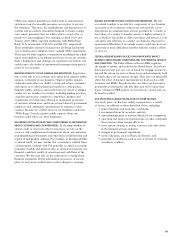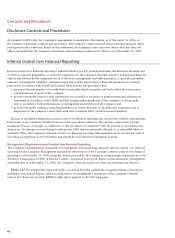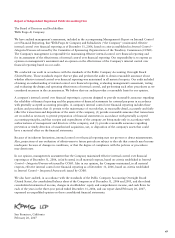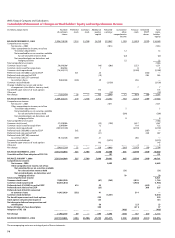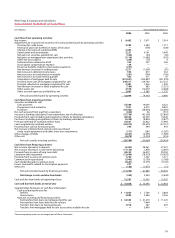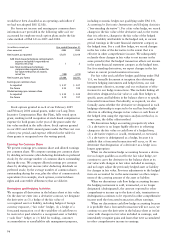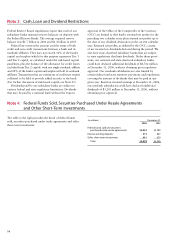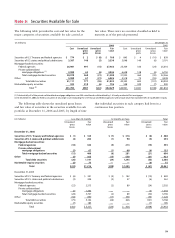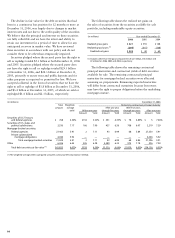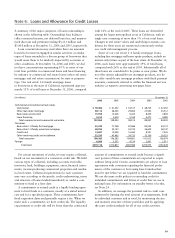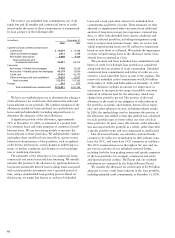Wells Fargo 2006 Annual Report Download - page 77
Download and view the complete annual report
Please find page 77 of the 2006 Wells Fargo annual report below. You can navigate through the pages in the report by either clicking on the pages listed below, or by using the keyword search tool below to find specific information within the annual report.
75
value upon the eventual disposition of the equipment. Leased
assets are written down to the fair value of the collateral less
cost to sell when 120 days past due.
Pension Accounting
We account for our defined benefit pension plans using an
actuarial model required by FAS 87, Employers’ Accounting
for Pensions, as amended by FAS 158, Employers’ Accounting
for Defined Benefit Pension and Other Postretirement Plans –
an amendment of FASB Statements No. 87, 88, 106, and
132(R). This model allocates pension costs over the service
period of employees in the plan. The underlying principle is
that employees render service ratably over this period and,
therefore, the income statement effects of pensions should
follow a similar pattern.
FAS 158 was issued on September 29, 2006, and became
effective for us on December 31, 2006. FAS 158 requires us to
recognize the funded status of our pension and postretirement
benefit plans on our balance sheet. Additionally, FAS 158
requires us to use a year-end measurement date beginning
in 2008. We conformed our pension asset and our pension
and postretirement liabilities to FAS 158 and recorded a
corresponding reduction of $402 million (after tax) to the
December 31, 2006, balance of cumulative other comprehensive
income in stockholders’ equity. The adoption of FAS 158
did not change the amount of net periodic benefit expense
recognized in our income statement.
One of the principal components of the net periodic
pension expense calculation is the expected long-term rate
of return on plan assets. The use of an expected long-term
rate of return on plan assets may cause us to recognize
pension income returns that are greater or less than the
actual returns of plan assets in any given year.
The expected long-term rate of return is designed to
approximate the actual long-term rate of return over time
and is not expected to change significantly. Therefore, the
pattern of income/expense recognition should closely match
the stable pattern of services provided by our employees over
the life of our pension obligation. To determine if the expected
rate of return is reasonable, we consider such factors as
(1) the actual return earned on plan assets, (2) historical rates
of return on the various asset classes in the plan portfolio,
(3) projections of returns on various asset classes, and
(4) current/prospective capital market conditions and economic
forecasts. Differences in each year, if any, between expected
and actual returns are included in our net actuarial gain or loss
amount, which is recognized in other comprehensive income.
We generally amortize any net actuarial gain or loss in excess
of a 5% corridor (as defined in FAS 87) in net periodic
pension expense calculations over the next five years.
We use a discount rate to determine the present value of
our future benefit obligations. The discount rate reflects the
rates available at the measurement date on long-term high-
quality fixed-income debt instruments and is reset annually
on the measurement date (November 30).
Income Taxes
We file a consolidated federal income tax return and, in
certain states, combined state tax returns.
We determine deferred income tax assets and liabilities
using the balance sheet method. Under this method, the net
deferred tax asset or liability is based on the tax effects of
the differences between the book and tax bases of assets and
liabilities, and recognizes enacted changes in tax rates and
laws. Deferred tax assets are recognized subject to manage-
ment judgment that realization is more likely than not.
Foreign taxes paid are generally applied as credits to reduce
federal income taxes payable.
Stock-Based Compensation
We have several stock-based employee compensation plans,
which are more fully discussed in Note 14. Prior to January 1,
2006, we accounted for stock options and stock awards under
the recognition and measurement provisions of Accounting
Principles Board Opinion No. 25, Accounting for Stock Issued to
Employees (APB 25), and related interpretations, as permitted
by FAS 123, Accounting for Stock-Based Compensation. Under
this guidance, no stock option expense was recognized in our
income statement for periods prior to January 1, 2006, as all
options granted under our plans had an exercise price equal
to the market value of the underlying common stock on the
date of grant. Effective January 1, 2006, we adopted FAS
123(R), Share-Based Payment, using the modified-prospective
transition method. Accordingly, compensation cost recognized
in 2006 includes (1) compensation cost for all share-based
payments granted prior to, but not yet vested as of January 1,
2006, based on the grant date fair value estimated in accordance
with FAS 123, and (2) compensation cost for all share-based
awards granted on or after January 1, 2006. Results for prior
periods have not been restated. In calculating the common
stock equivalents for purposes of diluted earnings per share,
we selected the transition method provided by Financial
Accounting Standards Board (FASB) Staff Position FAS 123(R)-3,
Transition Election Related to Accounting for the Tax Effects
of Share-Based Payment Awards.
As a result of adopting FAS 123(R) on January 1, 2006,
our income before income taxes of $12.7 billion and net
income of $8.5 billion for 2006 was $134 million and $84
million lower, respectively, than if we had continued to
account for share-based compensation under APB 25. Basic
and diluted earnings per share for 2006 of $2.52 and $2.49,
respectively, were both $0.025 per share lower than if we
had not adopted FAS 123(R).
Prior to the adoption of FAS 123(R), we presented all
tax benefits of deductions resulting from the exercise of stock
options as operating cash flows in the statement of cash flows.
FAS 123(R) requires the cash flows from the tax benefits
resulting from tax deductions in excess of the compensation
cost recognized for those options (excess tax benefits) to be
classified as financing cash flows. The $227 million excess
tax benefit for 2006 classified as a financing cash inflow


